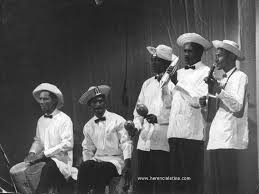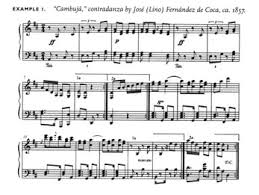NENÉ MANFUGÁS, EL PRIMER SONERO DE CUBA.
En los carnavales de Santiago de 1892 se vió a un negro colorao alto, fornido y de facciones toscas que meneaba la cabeza al compás de ritmo y que tocaba un extraño instrumento rustico, que tenía la forma de una cajita cuadrada de pino sin pulir, con brazo parecido al de una guitarra, pero más corto y tres cuerdas de hilo encerado, era Nené Manfugás y se decía que Nené lo había traído de Baracoa.
Se dice que en estos carnavales santiagueros (1892), la participación de Manfugás y su novedoso ritmo causaron una auténtica ´explosión´ de popularidad, que vino a consolidar el auge del son. El instrumento con el que se acompañaba Nené Manfugás finalmente terminó en el famoso “tres”, especial para el son y la música campesina cubana.
Al hablarse del ritmo Son se mencionan varios nombres como sus cultivadores importantes, sin embargo nadie se acuerda de quien es una de las figuras cimeras en la historia del son: Nené Manfugás.
Y ¿quién fue esta figura tan sobresaliente en el universo sonero?
NENE MANFUGAS IN MEMORIAM.
Nené fue un músico guantanamero, descendiente de haitianos y nacido a mediados del siglo XIX, emerge en las primeras décadas del siglo XX junto a Carlos Godínez, Arsenio Rodríguez, Isaac Oviedo y Eliseo Silveira como tesoro en la ejecución del Tres (Instrumento musical)- instrumento derivado de la guitarra y al que se atribuye haber introducido el ritmo Son en los ambientes urbanos, traído desde las zonas rurales en época finisecular y principios del siglo XX.
Manfugás era una especie de juglar que se movía por los montes intrincados, desde Baracoa hasta Santiago de Cuba; de naturaleza bohemia y aventurera, paseaba por esos caminos su canto a base de estribillos, acompañándose con un instrumento rústico derivado de la guitarra. Ese instrumento era una suerte del tres actual.
En las zonas antes mencionas, el trovador se popularizó al igual que su ritmo, y su presencia nunca faltó en las fiestas habituales en ese entorno montuno.
Como deciamos de Nené Manfugás, este era de naturaleza aventurera y de vida bohemia, y se hizo popular en las remotas zonas rurales de Baracoa ubicadas al oriente de la isla de Cuba. Fue cantante de sones e intérprete del instrumento rústico de tres cuerdas dobles y una caja de madera que seria el futuro llamado tres. Trasladó su música de los campos aislados de Baracoa a la gran ciudad de Santiago de Cuba alrededor del año 1880.
Se le atribuye haber introducido el ritmo del son desde el campo a los ambientes urbanos. También, se popularizó como uno de los primeros intérpretes del Tres (Instrumento musical) cubano. En aquel tiempo, los trovadores santiagueros, otros músicos, y agrupaciones existentes incorporaron el género en sus repertorios. Y fue tal el alcance del ritmo, que indiscutiblemente -al ser tan abarcador y generalizado- la ciudad se erigió como cuna del son.
El empuje del ritmo a principios del siglo XX (1909), invade la Habana por diferentes vías, a saber: algunos que viajaban a la Capital o iban de visita, aunque también existe la versión de que soldados músicos del Ejército Permanente, al ser trasladados hacia aquella ciudad, igualmente contribuyeron con la difusión del género; y no se pueden olvidar las frecuentes incursiones de Nené Manfugás por la gran urbe.
Nené Manfugás fue hermano de Andrea Manfugás Crombet, madre de la famosa pianista cubana Zenaida Manfugas que nos trajo, años despues, muchos premios y triunfos a la musica cubana nacional e internacionalmente.
Lo cierto es que el nombre de ese guantanamero, no debe estar ausente nunca cuando se aborde la historia del surgimiento y consolidación del son. Y es que a Manfugás le debemos el legado del ritmo y el uso más generalizado del tres, un instrumento imprescindible en el movimiento sonero.
NENÉ MANFUGÁS, THE FIRST SONERO OF CUBA.
At the carnivals in Santiago in 1892, a tall, stocky black man with rough features was seen shaking his head in time who played a strange rustic instrument, shaped like a square box of unpolished pine, with an arm similar to that of a guitar, but shorter and three strings of waxed thread. It was Nené Manfugás, he was the one who brought it from Baracoa.
It is said that in these Santiago carnivals (1892), the participation of Manfugás and its novel rhythm caused an authentic ‘explosion’ of popularity, which came to consolidate the boom of the son. The instrument with which Nené Manfugás was accompanied finally ended in the famous “tres”, special for Cuban son and peasant music.
When talking about the Son rhythm, several names are mentioned as its important cultivators, however, no one remembers who is one of the leading figures in the history of the son: Nené Manfugás.
And who was this outstanding figure in the sonero universe?
NENE MANFUGAS IN MEMORIAM.
Nené was a musician from Guantanamo, a descendant of Haitians and born in the mid-nineteenth century, emerges in the first decades of the twentieth century along with Carlos Godínez, Arsenio Rodríguez, Isaac Oviedo and Eliseo Silveira as the treasure in the execution of the Tres (Musical instrument) – instrument derived from the guitar and to which it is attributed having introduced the rhythm Son in urban settings, brought from rural areas at the end of the century and the beginning of the 20th century.
Manfugás was a kind of minstrel who moved through the intricate mountains, from Baracoa to Santiago de Cuba; Bohemian and adventurous in nature, he walked along these paths his chorus-based song, accompanied by a rustic instrument derived from the guitar. That instrument was a luck of the current three.
In the aforementioned areas, the troubadour became popular as well as its rhythm, and its presence was never lacking in the usual festivals in that Montuno setting.
As we said about Nené Manfugás, this was of an adventurous nature and of bohemian life and became popular in the remote rural areas of Baracoa located to the east of the island of Cuba. He was a singer of sones and interpreter of the rustic instrument of three double strings and a wooden box that would be the future called three. He transferred his music from the isolated fields of Baracoa to the great city of Santiago de Cuba around the year 1880.
He is credited with introducing the rhythm of the son from the countryside to urban settings. Also, he became popular as one of the first interpreters of the Cuban Tres (musical instrument). At that time, Santiago troubadours, other musicians, and existing groups incorporated the genre into their repertoires. And the scope of the rhythm was such that, unquestionably -because it was so comprehensive and generalized- the city emerged as the cradle of the son.
The push of the rhythm at the beginning of the 20th century (1909) invades Havana through different routes, namely: some who traveled to the Capital or visited, although there is also the version that soldiers-musicians of the Permanent Army when being transferred towards that city, they also contributed to the dissemination of the genre; and the frequent forays by Nené Manfugás through the big city cannot be forgotten.
Nené Manfugás was the brother of Andrea Manfugás Crombet, mother of the famous Cuban pianist Zenaida Manfugas who brought us, years later, many awards and triumphs to Cuban music nationally and internationally.
The truth is that the name of that guantanamero should never be absent when dealing with the history of the emergence and consolidation of the son. And it is that to Manfugás we owe the legacy of the rhythm and the more generalized use of the tres, an essential instrument in the sound movement.
Agencies/ Wiki/ SomosGuaracheros/ Rodulfo Vaillant/ Internet Photos/ YouTube/ Arnoldo Varona/ www.TheCubanhistory.com
THE CUBAN HISTORY, HOLLYWOOD.













